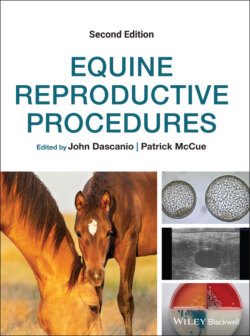Читать книгу Equine Reproductive Procedures - Группа авторов - Страница 57
Chromosomal Analysis Techniques Sample collection and shipping
ОглавлениеNote: the underlying principle of chromosome analysis is cell division during which metaphase chromosome spreads can be obtained. Therefore, the material (blood, tissue, biopsy, etc.) for chromosome analysis must contain live cells and be free of bacterial and fungal contamination. This is why chromosome analysis cannot be done from hair or frozen tissues.
Peripheral blood (~20 ml) is collected in green top (for cell cultures) and purple top (for DNA isolation) Vacutainer® tubes, wrapped individually in paper towels to prevent breakage, and shipped with refrigerator packs (do not freeze!). Shipping should be overnight or as fast as possible. Blood older than 7–10 days may not be suitable for cell cultures. Equipment and Supplies Laboratory equipment Laminar flow hood for sterile cell culture work, CO2 incubator regulated at 37°C (99°F), clinical centrifuge with a swing‐out rotor for 15 ml conical centrifuge tubes, water pump for liquid aspiration, water bath, a set of adjustable volume laboratory micropipettes, autoclave, refrigerator‐freezer, heating plate or hot oven, inverted light microscope with 20× and 40× phase‐contrast objectives, light microscope with a 20× phase‐contrast objective and a 100× objective, equipped with a CCD (charge‐coupled device) camera and image analysis software to capture metaphase spreads and arrange karyotypes.Supplies for cell cultures 7–10 ml sodium or lithium heparin (green top) and EDTA (purple top) Vacutainer® tubes and 20 gauge needles for Vacutainer® tubes for blood collection, sterile forceps and small scissors, sterile Petri dishes, sterile T25 and T75 cell culture flasks, sterile conical 15 ml centrifuge tubes, sterile serologic pipettes(1, 2, 5, and 10 ml), culture medium for blood lymphocytes: RPMI medium 1640 with Glutamax™ and 25 mM HEPES buffer (Gibco™; Life Technologies Ltd, Grand Island, NY, USA) supplemented with 30% fetal bovine serum (FBS; various suppliers), 1× antibiotic–antimycotic solution (100× stock; Gibco), 1% pokeweed mitogen (lectin from Phytolacca americana; Sigma Aldrich, Burlington, MA, USA). (Larger quantities (500 ml) of ready‐to‐use media can be prepared and stored in 9 ml aliquots in sterile 15 ml screw‐cap centrifuge tubes at –20°C. The tubes should be defrosted only once.) Culture medium for fibroblasts: minimum essential medium (MEM) α with Glutamax™ (Gibco) and nucleosides supplemented with 10–20% FBS and 1× antibiotic–antimycotic solution, sterile Hanks’ balanced salt solution (HBSS; Gibco), sterile 0.25% trypsin‐EDTA (Gibco).Supplies for cell harvest and chromosome preparations Ethidium bromide 1 mg/ml solution in double distilled water (ddH2O) (optional; prevents chromosome condensation), demecolcine solution to stop the movement of cell spindle and capture chromosomes at metaphase (10 mg/ml in HBSS (Sigma‐Aldrich, St Louis, MO, USA)), hypotonic solution to burst cytoplasm and release the chromosomes (optimal hypotonic solution (Genial Helix, Chester, UK) or 0.067 M KCl solution in ddH2O), fixative: methanol/glacial acetic acid in a ratio of 3:1, pre‐cleaned double‐frosted microscope slides, fine‐tip plastic transfer pipettes, Coplin jars.Supplies for chromosome staining and banding Giemsa stain (KaryoMAX® Giemsa Satin Solution; Gibco), Gurr buffer tablets (Gibco), 0.125% trypsin (stock 2.5%; Gibco), 0.1N HCl, 5% Ba(OH)2 in water, 2× saline sodium citrate (SSC) (stock 20× SSC).
A skin biopsy is collected for transport into sterile tubes containing collection medium: 10 ml HBSS supplemented with 2× antibiotic–antimycotic solution.
Cell lines: pre‐established cell lines can be shipped frozen in cryovials on dry ice or in culture flasks at room temperature. Culture flasks must be completely filled with medium to prevent detachment and damage of cells during transport.
